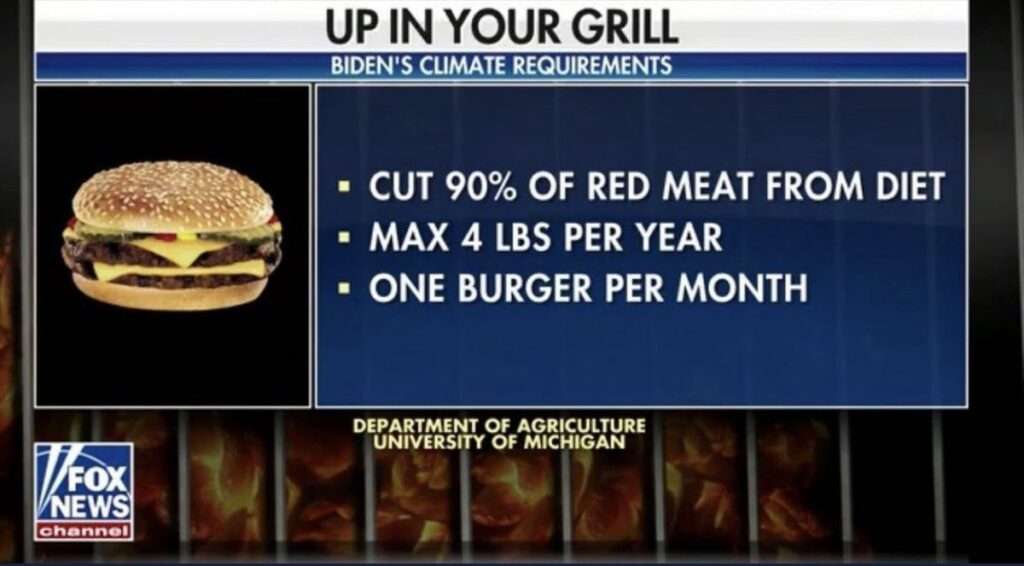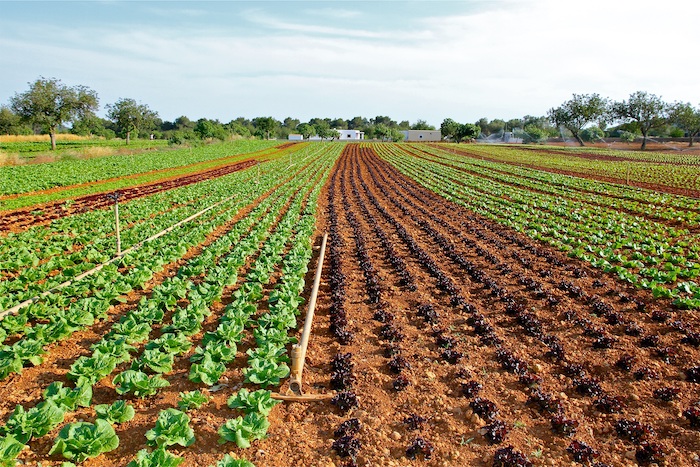We owe the modern factory farming system for the abundance of food lining supermarket shelves, but its drawbacks are well-documented: animal mistreatment, carbon emissions, tainted food, and soil degradation, among others. Unfortunately, there are several anti-farming proposals that sound good in theory – who wouldn’t want to curb animal abuse or reduce reliance on industrial-sized farms? – but they approach the issues incorrectly. It's akin to anti-gun laws that focus on the weapon rather than addressing the root causes of crime and societal issues. Good intentions, flawed strategies. Remember the recent hullabaloo when conservative media misinterpreted President Biden's agenda, suggesting he aimed to ban hamburgers? Well, this is connected. While Biden's rural plan emphasizes investing in sustainable agriculture and achieving net-zero emissions, the details remain vague. For instance, his proposal mentions assisting farmers in cutting emissions but doesn't specify how. Outlets like Fox News took a report from the University of Michigan proposing ways to cut emissions and claimed it was Biden’s official plan. Many of these proposals are still in the early stages, and feedback from the community might help temper the worst aspects. However, we believe it’s important to share these ideas so you're aware of the discussions happening within government circles, especially since they could significantly impact your ability to grow or raise your own food, not to mention the broader food supply chain. In Oregon, activists are collecting signatures to place initiative IP13 on the ballot, known as the Abuse, Neglect, and Assault Exemption Modification and Improvement Act. The bill itself is brief and somewhat confusing because it deletes more text than it adds. Essentially, it removes animal cruelty exemptions for farmers and animal husbandry practices, aiming to prevent "abuse, neglect, or sexual assault." The group behind IP13, End Animal Cruelty, explains its reasoning: No. This initiative would not ban the sale of meat, leather, or fur. It would, however, fundamentally alter how we treat animals, including those involved in animal agriculture. It would establish a system in Oregon where farmers are no longer exempt from animal cruelty laws. It would ensure animals live humane lives free from abuse, neglect, and sexual assault. Once an animal has lived a full life and passes away naturally and humanely, this initiative does not prohibit a farmer from processing and selling its body for consumption. In effect, the bill would mean: It would also likely have unforeseen, far-reaching consequences for transportation and common animal husbandry practices. Colorado’s Protect Animals from Unnecessary Suffering and Exploitation (PAUSE) initiative is quite similar. The main difference in the PAUSE bill is that animals could be slaughtered, but only after reaching 25% of their natural lifespan. The initiative defines these lifespans as follows: If these initiatives make it onto their respective 2022 ballots, I think they both have a strong chance of passing. After all, no one supports animal abuse, and many standard animal husbandry practices, like castration, appear barbaric to the uninformed. Let’s explore some potential ramifications of these initiatives. Drastically Reduced Meat Supply: Why are animals typically slaughtered at young ages? Because that’s when the meat is most tender. Meat chickens are usually slaughtered between six weeks to five months. Older chickens, usually laying hens, are better suited for soups or stews since the meat is too tough for roasting or frying. The same holds true for virtually all animals. USDA guidelines for grocery store beef grades (Prime, Choice, Select, and Standard) do not permit cattle older than 42 months. Under PAUSE, cattle couldn’t be slaughtered before the age of five, pushing them into the lower grades, only suitable for ground meat or pet food. Juicy steaks raised in Colorado? Forget it. You might have to marinate and pound the meat into submission. Moreover, the longer you keep an animal, the greater the likelihood of sudden death from natural causes or predator attacks. It’s not difficult to keep a flock of chickens alive for a few months, but maintaining them for two years is much trickier. Even the best farmers experience losses during that time. For IP13 in Oregon, forget about meat production, despite what proponents claim. No one harvests meat from a dead animal – unless they’re starving – because it spoils rapidly. That’s why it’s crucial to gut an animal soon after slaughter to lower the meat temperature and prevent pathogen growth. Dramatically Higher Meat Costs: A smaller meat supply will naturally drive up prices, but keeping an animal alive longer means feeding it more, and feed isn’t free. Everyone selling animals or meat for profit must factor feed costs into their pricing. If I spend $20 a month feeding a flock of ten birds, that’s $2 per bird per month. Buying chicks at $4 each, I’d have to charge $6 just to break even on eight-week-old meat birds. If I had to keep those birds for two years, I’d need to charge at least $52 per bird. Again, you won’t be making fried chicken with these birds, and I’ll have fewer to sell due to flock losses. Injuries to Animals and People: Farmers castrate male animals for three main reasons: However, for small-scale farmers, injuries are perhaps the biggest concern. Imagine managing a herd of raging bulls without the option to cull them. And they’d have to if artificial insemination were illegal because there would be no other way to produce calves or obtain milk. Artificial insemination is safer for farmers, safer for cows and heifers, and allows ranchers to choose the best genetics. I don’t raise cattle, only chickens, but roosters are challenging enough. I’ve received some vicious pecks from roosters, and they can do significant harm to hens during mating. I’ve culled a few for my safety and the safety of my flock. I can’t fathom the nightmare of an entire herd of uncontrollable bulls I couldn’t cull for five years. Animal Deaths During Childbirth: Something that caught my attention in the PAUSE legislation: SEXUAL ACT WITH AN ANIMAL ALSO INCLUDES ANY INTRUSION OR PENETRATION, HOWEVER SLIGHT, WITH AN OBJECT OR PART OF A PERSON’S BODY INTO AN ANIMAL’S ANUS OR GENITALS. Anyone familiar with cattle, or who has even seen a movie about cattle ranching, knows that many cows need assistance during birth. Iowa State University states, “While 70 percent of cows will deliver without assistance, only about 50 percent of heifers [first-time mothers] will deliver without assistance.†Assistance usually involves putting on gloves, reaching into the cow or heifer, and pulling out the calf. If PAUSE were implemented, ranchers would often face an agonizing choice: risk being charged with a felony and being placed on a sex offender registry, or allow both mother and baby to suffer a painful death. It’s probably no surprise to you that our food supply is tainted. It seems like every other week we hear about a salmonella, E. coli, or listeria outbreak in the food chain. Recently, the FDA released a report on a fall 2020 E. coli outbreak, pinning the blame on cattle runoff, causing raised eyebrows among insiders. The report states: Considering this, we recommend that all growers be aware of and consider adjacent land use practices, especially as it relates to the presence of livestock, and the interface between farmland, rangeland and other agricultural areas, and conduct appropriate risk assessments and implement risk mitigation strategies, where appropriate. Increasing awareness around adjacent land use is one of the specific goals of the Leafy Greens Action Plan we released last March, which we’re also announcing is being updated today to include new activities for 2021. In short: E. coli has been linked to cow manure, and leafy green producers should anticipate potential contamination from nearby cattle, even if the cattle aren’t on their land, and those producers are expected to mitigate such contamination. Although the FDA doesn’t oversee the cattle industry – that falls under the USDA – this could set the stage for ranchers to be held accountable for E. coli outbreaks as well. Michael Taylor, a lawyer who served as Deputy Commissioner for Foods and Veterinary Medicine at the FDA from 2010 to 2016, said: This finding seems obvious and shouldn’t be surprising. The surprise, however, is that FDA used regulatory language to express its finding and spelled out the implications: farms covered by the FSMA produce safety rule “are required to implement science and risk-based preventive measures†to minimize the risk of serious illness or death from the E. coli hazard. Marion Nestle, the retired Paulette Goddard professor of nutrition, food studies, and public health at New York University, asked, “But leafy green safety is overseen by FDA whereas everything having to do with food animals is overseen by USDA…The Big Question: Will—can—the FDA force cattle ranchers and leafy green growers to adhere to food safety precautionary measures?†Bill Marler, an attorney specializing in foodborne illness litigation, advised restaurants: Relying on a contact between the restaurant and its leafy green supplier is now not enough. Given the FDA pronouncement, restaurants need to affirm that the product be grown in an area where the “adjacent land†is not a “reasonably foreseeable hazard.†It’s unclear where this FDA stance might lead. Taylor doesn’t think the FDA will enforce it except under extreme circumstances, but I can envision a future where leafy green producers sue neighboring cattle ranches for economic damages, either due to FDA action or restaurants refusing to buy from producers near cattle ranches, which is more common than you’d think. Not to mention that many organic growers use good old cow manure to fertilize crops. Instead of threatening leafy green producers, it would make more sense to combat E. coli at the source, and there are several options the industry has yet to embrace: Cattle ranchers don’t worry about E. coli because it doesn’t affect the cows much at all, just the people who eat undercooked meat or those affected by tainted manure. Hopefully, this nudge from the FDA will encourage more ranches to mitigate E. coli rather than forming government cattle execution squads. Meanwhile, on the other side of the globe, Australian farmers are opposing a draft rule by the Environmental Protection Agency Victoria that would classify manure as industrial waste. Australian farmers are baffled by the rule, as manure has always been a key fertilizer throughout the history of agriculture. Allan Bullen, a chicken farmer and representative of the Victorian Farmers Federation, said: “Farmers have been utilizing animal manure as a sustainable by-product of agriculture for decades. To lump them with increased bureaucracy is baffling.†Indeed, as an (mostly) organic gardener, the fight against cow poop is perplexing. One of the great overlooked crises is the widespread loss of topsoil. A recent Yale report stated that the United States Corn Belt has lost ⅓ of its topsoil: nearly 100 million acres, thanks to industrial farming practices. The Union of Concerned Scientists said: If soil continues to erode at current rates, U.S. farmers could lose a half-inch of topsoil by 2035—more than eight times the amount lost during the Dust Bowl. They could lose nearly three inches by 2100. Given that it takes a century or more for an inch of soil to form naturally, the United States will lose the equivalent of at least 300 years’ worth of soil by 2100 if today’s trends persist. Unless something is done, the world could face a famine worse than the Dust Bowl. We need to not only stop the loss of topsoil but also replenish what’s been lost, and the single best way to build up soil is by adding organic matter like manure. We need to use all the poop we can get. And there’s evidence that animal-based regenerative farming practices can actually reduce carbon emissions. pva water soluble film,water soluble polyvinyl film,pva water soluble film packing machine Rongxin New Material (Jiangsu) Co., Ltd. , https://www.rongxinxcljs.comOregon Initiative IP13
Colorado PAUSE
Impact on Meat Production and Self-Sufficiency
FDA, Cattle, and Leafy Greens
Manure: Industrial Waste or Soil Savior?


